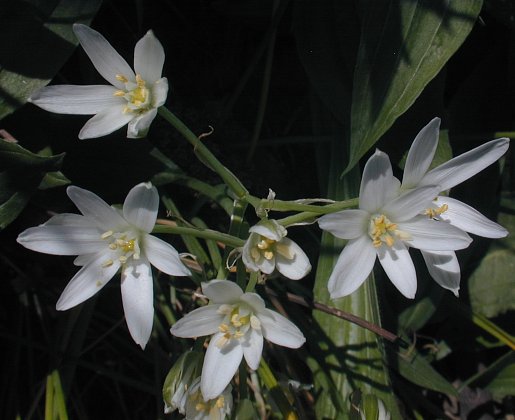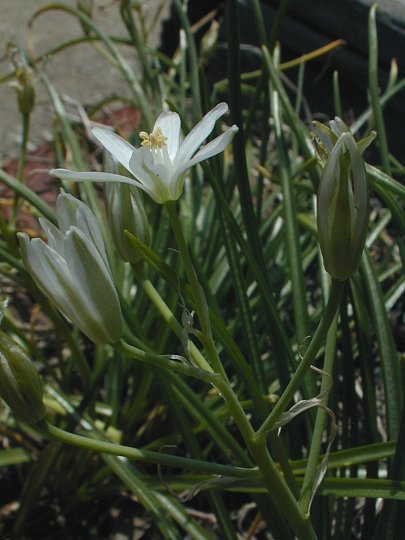Description: This herbaceous perennial plant consists of a rosette of basal leaves spanning about 1' across. These linear leaves are about 6-12" long and up to ¼" across. They curve upward from the base and bend downward around the middle. There is often a white stripe in the middle of each leaf, which has smooth margins and parallel venation. From the center of the rosette, there develops one or more flowering stalks about 6-9" tall. Each stalk terminates in a cyme-like raceme of white flowers. This raceme is rather short and spreading. The lower pedicels are 1-3" long, while the upper pedicels are somewhat shorter. Both the basal leaves and flowering stalks are hairless.

Each flower is about 3/4" across when fully open, consisting of 6 white tepals, 6 stamens, and a single pistil. Each tepal is lanceolate-oblong; there is a green stripe along its outer side. A stamen has a yellow or light brown anther at its apex, and a white filament underneath. This filament is lanceolate or narrowly triangular in shape (tapering at the top), which is a distinctive characteristic for this species. The blooming period occurs during the late spring and lasts about 2 weeks. There is a pleasant floral scent. The flowers open during the morning and usually close by noon. Each flower is replaced by a 3-celled seed capsule containing several black seeds. The root system consists of a bulb about 1" long that is ovoid. This plant reproduces by its seeds and vegetative offsets (primarily the latter). It often forms dense colonies that can exclude other species during the spring.

Cultivation:
The
preference is full sun to light shade, moist to mesic conditions, and a
fertile loam. Growth occurs during the spring; the foliage withers away
by mid-summer. This plant has few problems with pests and disease; the
waxy foliage resists contact herbicides.
Range & Habitat:
The Star-of-Bethlehem naturalizes occasionally in southern, central,
and NE Illinois, but it is less common in the NW area of the state (see
Distribution
Map). It is often cultivated in flowerbeds, from which it
occasionally escapes. Habitats include cemetery prairies, grassy
meadows, sunny or semi-shaded banks of streams and drainage ditches,
and miscellaneous waste areas. This species is usually found in
degraded sites, although it can invade high quality natural habitats
and displace native species of plants that bloom during the spring. The
Star-of-Bethlehem is native to eastern Europe and parts of the Middle
East; it was introduced into the United States as an ornamental plant.

Faunal
Associations: The
primary pollinators of the flowers are probably bees. The foliage and
bulbs contain toxic alkaloids that can poison livestock. The cooked
bulbs are reportedly edible to humans, although suitable caution should
be exercised.
Comments:
The Star-of-Bethlehem is a surprisingly aggressive little plant with
attractive flowers. Key features include the spreading racemes of erect
flowers, and the triangular or lanceolate filaments underneath the
anthers. These filaments are erect and surround the pistil. Other
members of the Lily family that are somewhat similar in appearance
include the Allium spp. (Onions) and Nothoscordum
bivalve (False Garlic). However, False Garlic and the various
species of Onions have umbels of flowers and the filaments of their
flowers are thread-like. Another cultivated plant, Ornithogalum
nutans (Nodding Star-of-Bethlehem), rarely escapes into the
wild. It has nodding flowers on elongated racemes and each of its
filaments have a pair of small teeth at the apex. The pedicels of this
latter species are usually ½" or less.